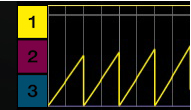Loading and saving patches is done in the same way as with any other internal Reason device, see “Loading patches” and “Saving patches” for details.
To replace the current modulation curve with a different curve anywhere in the modulation loop, use the same principle as described above in “Changing an existing curve’s amplitude”. The only exception here is that you now freely choose the new curve shape, regardless of the existing curve shape. You can replace an existing curve in as many places throughout the loop as you like.







